But the undercount of mass-immigration distorts the household data.
By Wolf Richter for WOLF STREET.
In April, employers added 175,000 payroll jobs – excluding farm workers and the self-employed – a slower pace from the upwardly revised March estimate of 315,000 additions, which had been huge. Over the past 12 months, the range has been between 165,000 and 315,000.
Over the past three months on average, employers added 242,000 jobs per month. This three-month average – which includes the revisions and irons out the artificial drama of the monthly squiggles – is high for normal times. Over the past 12 months, 2.8 million jobs were added. All according to the survey of employers — the “Establishment survey” by the Bureau of Labor Statistics today.
We can quibble with some of the details of the jobs report, and we’ll get to them, but overall, it was a solid picture of a strong labor market, with some factors normalizing from the pandemic distortions. It’s what you’d expect from an economy that’s plugging along at a pace that is faster than the normal pace over the past 15 years.

The total number of payroll jobs rose to a record 158.3 million:
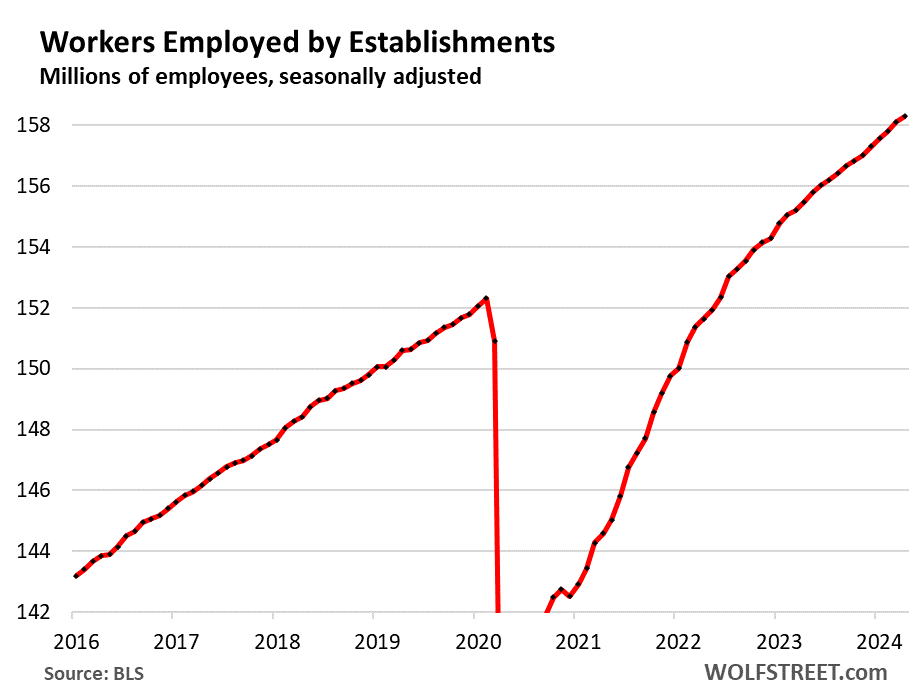
Average hourly earnings rose in March at an annualized rate of 2.4%, the smallest increase in three years, also according to the “Establishment” survey data. Compared to a year ago, wages were up 4.0%:
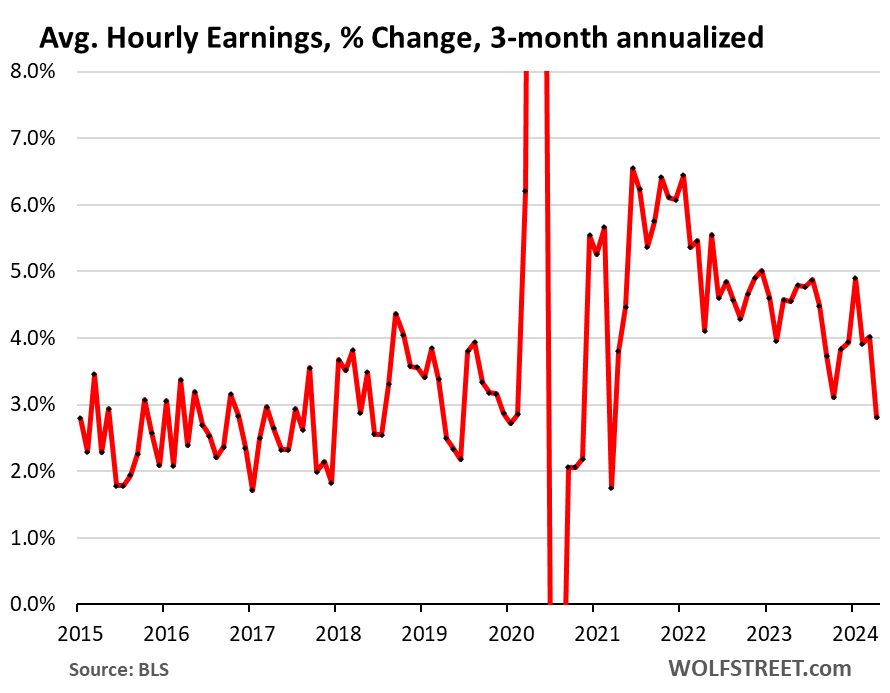
Household survey data and mass immigration.
The BLS bases its employment and unemployment figures on the household survey data, which uses the population data from the Census Bureau. But an issue has been dogging the data for the past two or so years: The Census Bureau has massively underestimated population growth in its model by failing to account for the huge wave of mass-immigration in 2022 and 2023.
The Congressional Budget Office, however, has picked up on the surge of immigration and therefore the big population growth in 2022 and 2023. We discussed this and how it messes up the BLS household employment data. These are the two diverging population growth estimates:
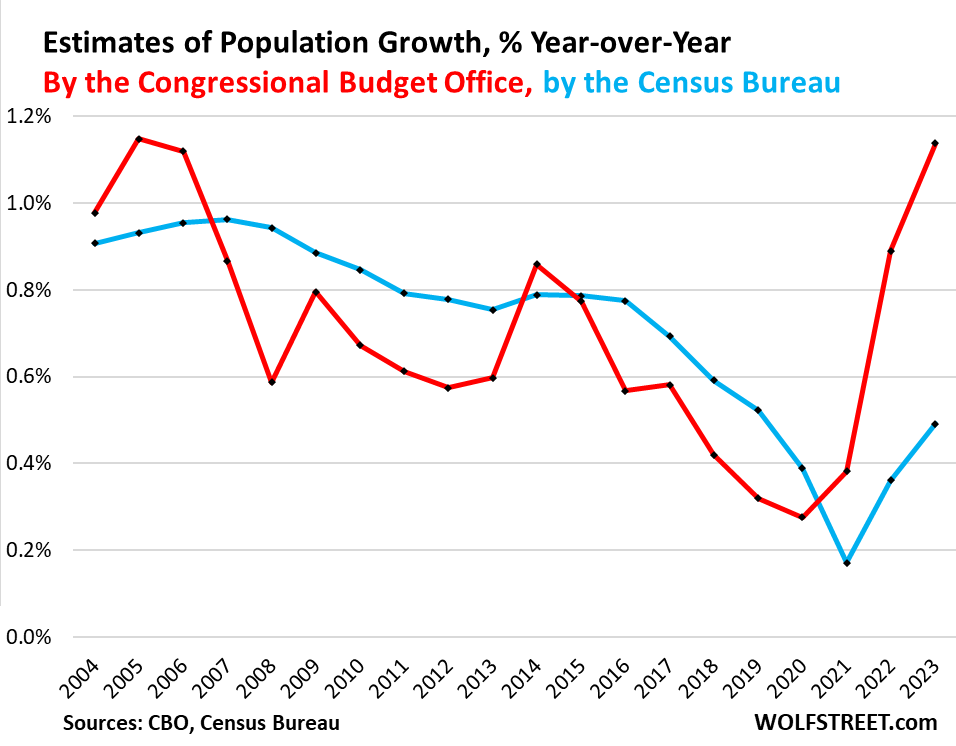
The BLS, by applying its household survey data to the underestimated population count from the Census Bureau, understates total employment and the labor force which then distort all the other data.
Overall employment, which includes farm workers and the self-employed, and is based on the survey of households, had been rising roughly in parallel with payroll jobs from the employer survey (above). In the years before the pandemic, total employment was about 6.5 million higher than payroll jobs.
But since the vast undercount of immigration and therefore population growth from 2022 on, the difference has shrunk to just 3 million, from over 6 million.
The total number of workers per the household survey rose to 161.5 million. The three-month average rose to 161.3 million (red), which is just 3 million higher than the 158.3 million payroll jobs (blue).
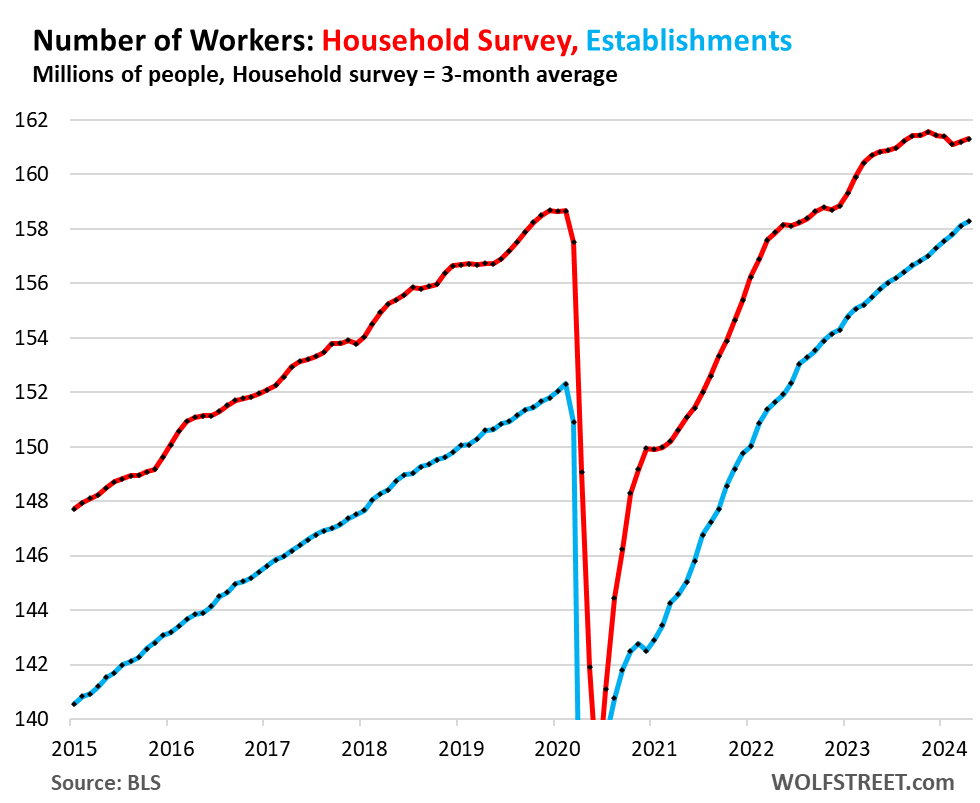
And the difference between the two has shrunk to just 3 million as the employer data picks up the new workers, but the household data is applied to the underestimated population data. The Census Bureau needs to revise its population data to account for the big wave of immigration, which would fix this issue here:
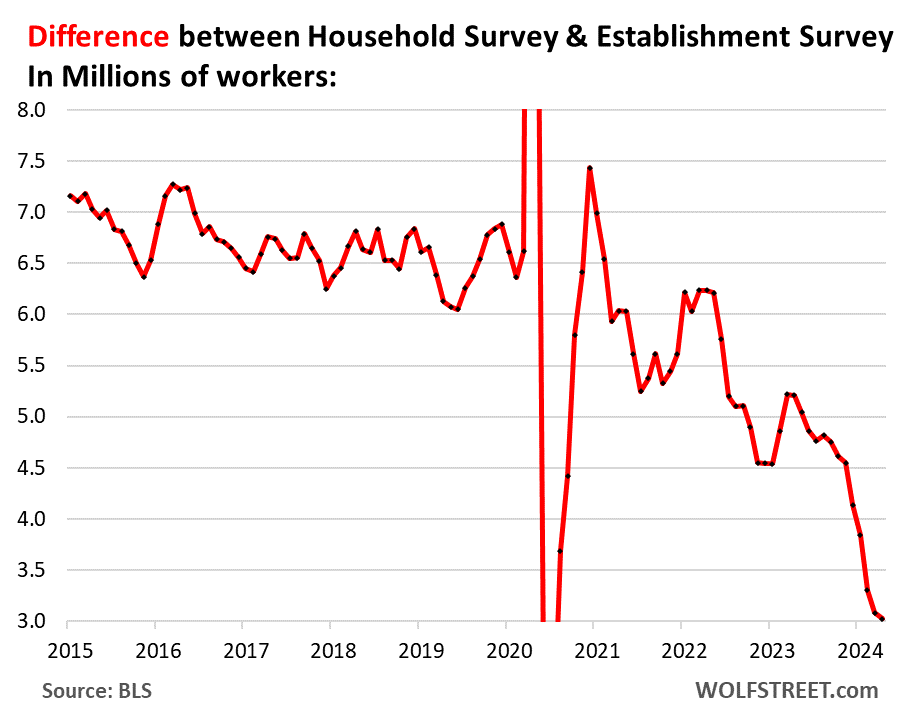
The number of full-time workers jumped by 949,000 in April to 133.9 million.
Remember the undercount of the population? If counted correctly, this number would be much higher. This is one of the many charts that show the bizarre effects of the population undercount:
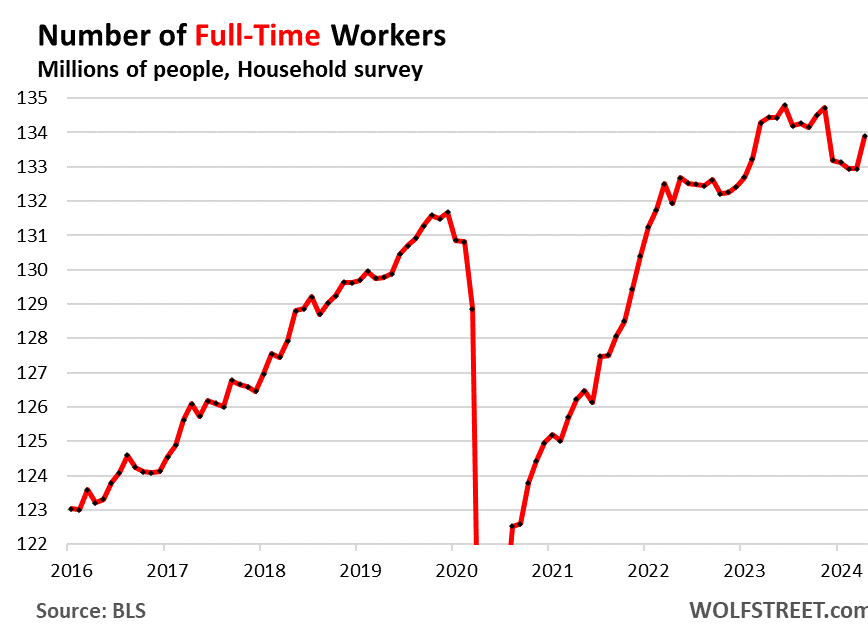
Part-time workers fell by 914,000 to 27.7 million. The three-month average fell to 28.1 million. As a percent of all workers, part-time workers dipped to 17.4%:
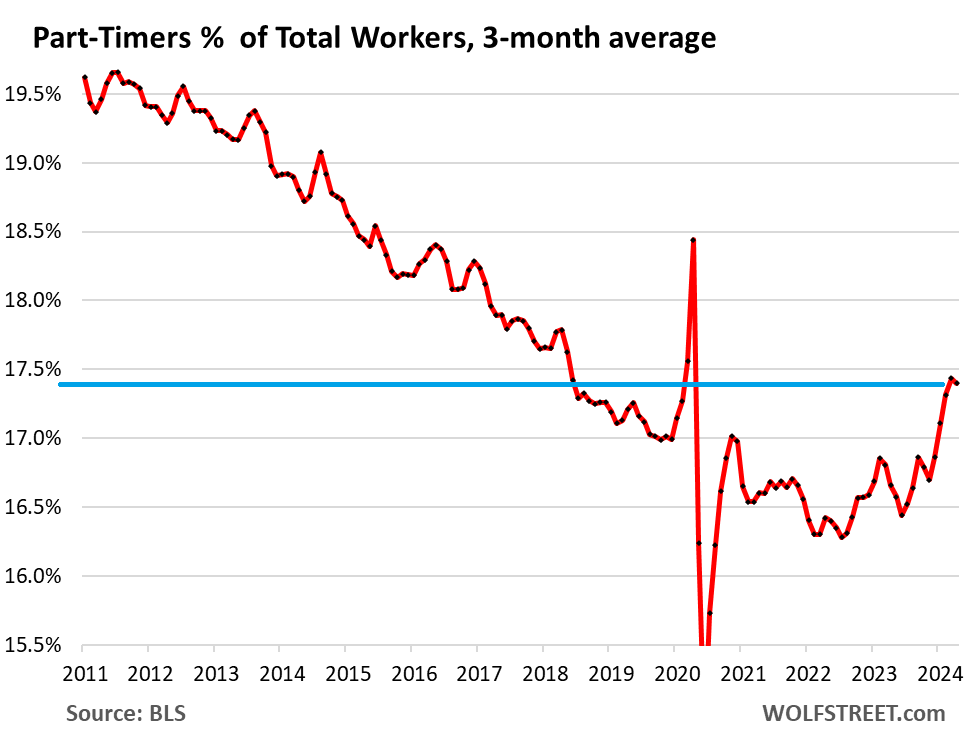
The labor force rose by 87,000 to 168.0 million. The labor force consists of people who are working and those who are not working but actively looking for work. It is also massively understated by the population undercount over the past two years.
That the labor force has dropped in prior months, despite the huge influx of immigrants looking for work or already working, demonstrates the impact on the Census Bureau’s undercount of immigration:
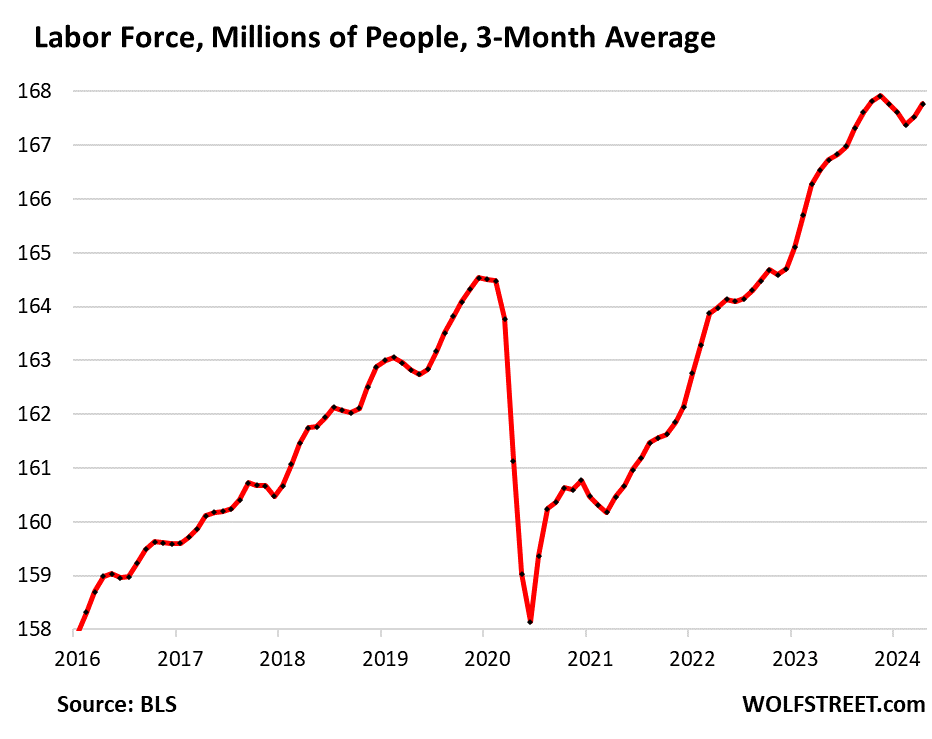
The prime-age labor participation rate – people between 24 and 54 – has returned to the multi-decade-high of 83.5%:
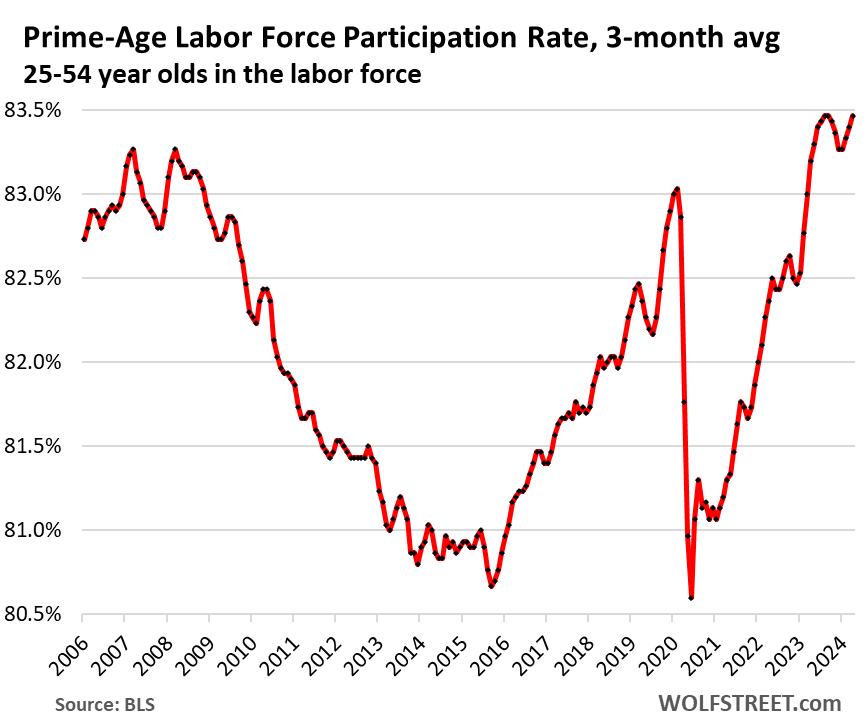
The number of unemployed rose to 6.49 million (blue). The three-month average rose to 6.46 million, where it had been in April 2018 (red).
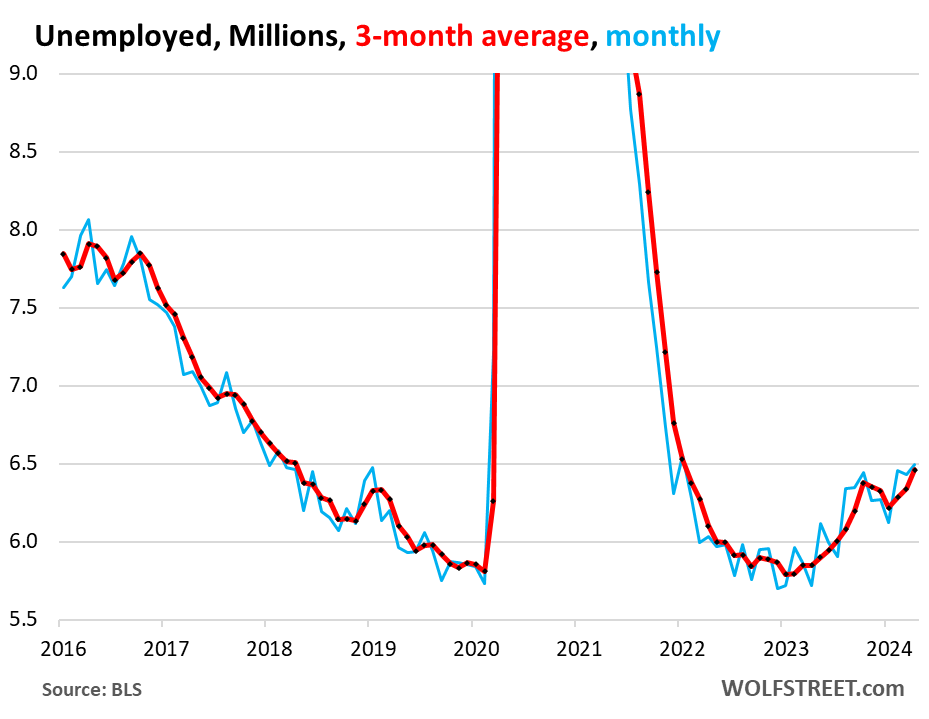
The unemployment rates ranged from 1.3% for U-1, the narrowest definition, to 7.4% for U-6, the broadest definition.
U-3 is the headline unemployment rate (red in the chart below). It ticked up to 3.9% in April, same as in February. Overall, the rates have been edging higher but remain low compared to prepandemic years:
- U-1: 1.3% (persons unemployed 15 weeks or longer, % of civilian labor force)
- U-2: 1.9% (job losers and persons who completed temporary jobs, % of civilian labor force)
- U-3: 3.9% (total unemployed, % of civilian labor force; official unemployment rate)
- U-4: 4.1% (total unemployed plus discouraged workers, % of civilian labor force plus discouraged workers)
- U-5: 4.8% (total unemployed, plus discouraged workers, plus all other marginally attached workers, % of civilian labor force plus all marginally attached workers)
- U-6: 7.3% (total unemployed, plus all marginally attached workers, plus total employed part time for economic reasons, % of civilian labor force plus all marginally attached workers).
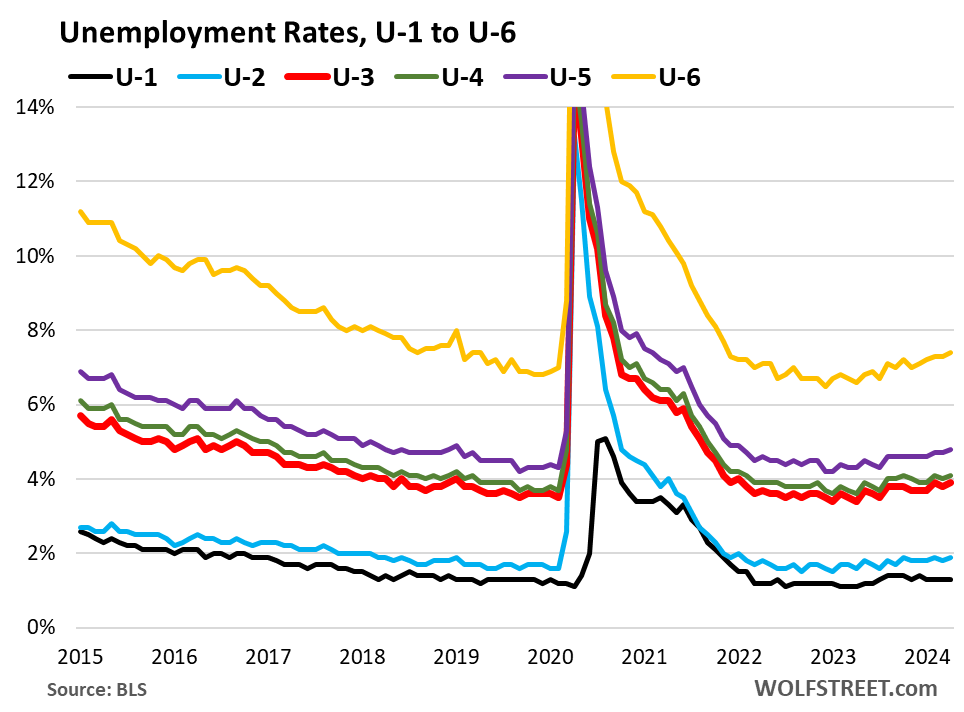
Multiple jobholders as percentage of total workers have been just below 5.2% for five months in a row (three-month moving average), having returned to the normal range over the past 15 years. Before 2009, the rate was much higher.
Who are multiple jobholders? They include: corporate employees with a side gig, such as consultant or being a landlord with some housing units (small landlords with 1-9 rentals own 11 million single-family houses for rent, so this is a biggie); university educators who also work as consultants; engineers with a startup side gig; restaurant workers with revenue-producing YouTube channels; restaurant workers working shifts at different restaurants; cops working off-duty as security; people working from home doing two full-time tech jobs before they get laid off by one of them; executives who also serve as paid member of the board at other companies…. We all know some of them. Multiple job holders span the spectrum.
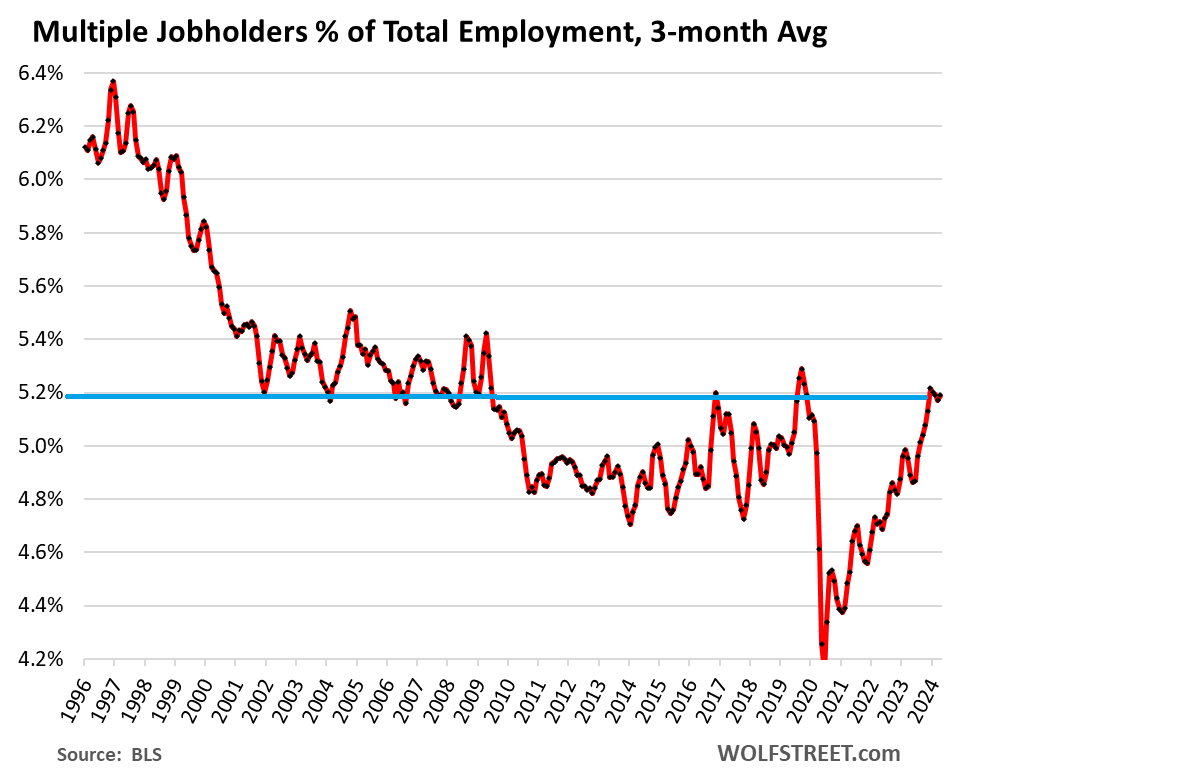
Enjoy reading WOLF STREET and want to support it? You can donate. I appreciate it immensely. Click on the mug to find out how:
![]()


It’s quite a big stretch going from +175K/month to cutting rates as markets hope to get. It’s still a solid number.
The determining factor will be inflation. This is how I see it:
If inflation vanishes, we’ll likely see rate cuts;
if inflation stays hot on a three-month basis, we won’t see rate cuts;
if inflation gets ugly, we may see a rate hike (December meeting maybe?).
I have been following your thinking on inflation and rate hikes for a couple of years and you really nail it. Thank you. To be honest, I don’t always agree with your perspective, e.g. on electric cars, but I l live in Canada which is zero infrastructure for them and weather that messes with the batteries. They are popular enough in towns, but you see very few of them on the TransCanada highway and none in the mountains in winter. Time will tell on that I know, but on interest rates and inflation, you’re infinitely more insightful than … say, Paul Krugman.
Is Wolf more insightful than Milton Friedman? If not, why one and not the other?
Just wondering since you are rating him, and he doesn’t have his “Nobel prize” from the Swedish Fed yet….like the other two do.
Seems like every time I look at a chart these days, most of them are back on their pre pandemic trajectories. Personal opinions aside, the economy as a whole is doing just fine. All we appear to have done is jacked up prices and profits in a lot of industries, while at the same time increasing pay just enough to cover most of the increases. Savings and higher interest income is covering the rest. It’s really not a bad scenario.
With the exception of current home buyers and the lowest income bracket, everyone seems to be rolling right along. 3-4% inflation isn’t really the problem. It’s more about the 20 – 50% permanently higher prices.
We should be doing very well with the extra deficit pumped into the economy. The dollar rules. Of course the good times continue. Enjoy while it lasts. We could have another ten years of dollar thrill- tickle it with a feather good times in the good ol USA. Like a beer commercial: “Boys, it don’t get no better than this”.
“most of them are back to their pre-pandemic trajectories” Agree. Which is one of the things I value about the charts in this site. The longer horizon is insightful.
“its more about the 20 – 50% permanently higher prices.” Again, agree. IMO people understand that food (groceries or restaurants) are dramatically higher than recent memory. That contributes to the low consumer sentiment surveys. People know.
This site is very helpful. Lots of data but a narrow focus on inflation / rates. My question is “When?”. When will the charts (economy) roll over? We know its a cycle. We know its not different this time. What we don’t know is “When”.
Thanks again for the detailed views of the data, the commentary and the community feedback. This site helps me. Read it every day.
CCCB,
You say all is good, but federal deficits and the debt-t0-GDP ratio are at ridiculous levels, which is straining government financing. Have you seen Wolf’s chart of interest cost? Wealth concentration and societal discontent are very high, so depth charges (pun intended) could disrupt the system. A significant portion of the population has been locked out of RE and investment markets. People (and central banks) are seeing reason to hedge with unproductive assets like Bitcoin and gold. The “economy” is increasingly exploited by a small group of large players to the detriment of small business owners and the majority of workers.
Things are “good”, in a sustainable sense, for only a modest subset of the population.
Wasn’t it such tunnel vision that resulted in the Great Recession? I recall an establishment economist saying “there is no housing crisis” a few months before the housing crisis began. Given the boom-bust pattern of the past 30 years, I am not surprised by that. Stupidity and myopia are going to be continually surprised.
How many people would be unemployed today if the government simply stopped increasing the debt-to-GDP ratio?
@Bobber,
Boom bust cycle of last 30 years?
More like a boom cycle for the last 20 years. Since late 2000s we have not had a bust cycle. COVID was an artificial mandated short term bust.
Prior to 2007 we would get boom busts every 7 years – not any longer.
No rate cuts with the stock market continuing to perform like it has recently.
No rate cuts thru EOY is my prediction too.
Central bankers and politicians are creaming their pants for rate cuts in order to get back to the cheap money bullshit. They’ve f**ked the whole country up beyond repair, and they want to do it even more.
Banker need cheap money as they are underwater with worthless treasuries/loans earning 0% interest.
Inflation is going to get ugly. End of story.
I think the results of manmade climate change will be MUCH uglier than the mere manmade book keeping’s unfair “errors”.
And possibly a REAL “end of story”, since no other large land mammals talk and write….ie, ” tell stories”.
Inflation is still entrenched. This jobs report will have zero impact on the Fed funds rate decisions.
yes you are right. people who want jobs still have them and aren’t reducing their spending out of fear. that’s the only thing that stops entrenched inflation.
Looks like no rate cuts this year.
I read the other article but couldn’t find whether the immigration increase is mostly undocumented, H1B or something else?
All combined. It’s about total population increase. More people showing up in this country and increasing the US population a lot faster than the model from the Census Bureau estimates.
Funny that the UK had Brexit to reduce immigration but US and (especially) Canada increased immigration voluntarily.
Two different strategies.
Brexit was to protect the national interest: keep the currency and people working effectively.
North America is about exporting paper and importing cheap/ slave labor.
Humans have been commoditized!
Is there a retirement wave that’s giving cause to a hiring boom? Back in 2009-2015 my Millennial cousin was told by a job agency that she had to work for free or volunteer at a company before getting a paid. Even former BOC Governor Poloz said something to that effect at the same time.
Back in 2021, 14-year-olds were getting paid C$18/hr working at McDs before the “international student” wave decimated the part-time and entry level job markets a few months later in 2022 to present.
You should ad that you are talking about totally dystopian Canada, a step up on the quite dystopian US.
Canada is definitely dystopian for sure you bet with these internet speech laws that are in force, and those being proposed.
They want people to exist just to spend their money on rent and food while saving nothing for the future and the future of their children, because a million so-called international students are in Canada working 40 hrs a week or more.
I’m wondering why the BLS is distorting the statistics, if their cousin Bob wasn’t around we would be a bit off course.
Does it make a difference, this distortion? … Most definitely, look at the chart.
What’s their reasoning.
Lots of opinion in your dystopian statement but no data. I’m pretty sure it isn’t a representative view, but then again that is just my opinion. I’m also pretty sure there isn’t some vast conspiracy out there to screw everyone out of a future.
Can’t post links unmoderated here Paul. Just check the polls for the federal election. No need to pick on my comment like the thought police.
These international students are about as productive as a broken down washing machine. More students have to be hired to do the same jobs as in the past. I haven’t formulated the ratio yet but it seems to be about 25 percent more foreign workers to do the jobs of local Canadians.
18-22 year-old international students can’t really compete with blue collar workers with years of doing hard work since their teens.
By the way, it’s tragic that a baby and their grandparents died in a horrific crash during a wrong way police chase in Belleville Ontario. The suspect was an international student who was on bail for robbery.
apparently 3.9% unemployment is now a bad number that justifies rate cuts
Yes, I thought that was kind of funny too.
The sky was falling this morning according to some websites.
Wolf, Thanks for the excellent info. Let us assume, CBO adjusts the immigration and BLS updates its data.in that scenario what would be the unemployment rate? Any idea? Thanks
Total employment would be higher, and the labor force would be higher and I think unemployment would be higher. I’m not sure about the ratios though, such as the unemployment rate, because in my thinking, the inaccuracy shows up both in the numerator and in the denominator and would seem to cancel out.
And would the mass immigration people have a tougher time finding employment ? I have not idea i would hire the most qualified cadidate provided they are here legally
The “best” candidates aren’t here legally. BUT because of that: They’re cheap!
I have never seen my boss happier than when he was reveling that “he doesn’t have to pay contract workers benefits!”
“Contract workers” is code for undocumented. He pays a “company” that pays them. The “company” is owned by an employee of ours… no conflicts and totally above board, I’m sure!
Jobs report seems slightly soft but certainly still strong labor market…ISM services going into contraction but with much higher prices is not so good. Another report pointing to stagflation.
I think that’s what will make this year and the next so difficult for rate cuts.
Growth seems to finally be slowing down but the path to inflation coming down to 2 not so much
Appears rate cut mania is alive and well.
appears that the narrative is that eventually the fed and ecb will cut rates back to 0 or even negative in the latter case, so all assets should be priced for that eventuality.
Really? Is that just wishful thinking, a wet dream or something you hope is going to happen?
How would the inflation issue be resolved by doing that?
Or the housing-unaffordability issue?
Social cohesion, social unrest, social trust?
Inequality?
Deficit spending?
The debtburden?
Servicing this insane debt?
Anyone?
Bueller?
The problem is that history shows us paper currencies are made to be “ridden hard and hung up wet”, ie, inflated away in pursuit of power domestically or abroad.
So now I’m asking you, Harry, are you saying the dollar is going to be the first of 3,000+ paper currencies throughout history to not be inflated and last forever ?
Wolf, thanks for sharing these excellent stats. Hopefully inflation will disappear and pricing drops. If not, things will be even crazier ahead! Let’s see what happens
The sickest aspect of this monetary insanity is the ‘pivot’ crowd.
As long as they get their speculatative payout, who cares about debt, inequality, assetbubbles and social unrest.
Of course the media are behind these buzzword narratives ‘pivot’ ‘rate-cut’ ‘rate-hike’ ‘transitory’ ‘supercore’ ‘the economy is booming’.
This is about a class war. Those that hold all the wealth by manipulating the workersbees into owning nothing and being miserable.
That punchline holds so much truth and it really says it all.
“This is about a class war”
Not a very good war, this class war, more like no war at all, just a boot in the ass for the poor… the misery of these rising prices.
I agree.
Any data, that could be perceived as even slightly negative, is used by the Fed Pivoteers to justify all these doomsday narratives that will require rate cuts.
Slightly higher unemployment? GIMME RATE CUTS!!
Slightly lower inflation? GIMME RATE CUTS!!
The Pivoteers are sounding like a broken record.
Interesting findings Wolf, thanks for sharing. I agree, maybe the inaccuracies in both the numerator and denominator cancel one another out.
Powell apparently mentioned indeed as an additional resource yesterday and indeed said the labor market is cooling.
That cooling, connects to consistent data revisions which probably will result in lower GDP and higher unemployment many months from now.
The undercounting of immigration obviously isn’t positive, especially as things slow down.
The mass immigration is inflationary (for example, rents but also other consumption) and supplies lots of labor to the labor market.
Powell said that the labor market was still tight, but that some of the pandemic distortions had settled down.
Mass immigration and inflation.
I tend to have my head in the sand about that, in denial, but just read a story from a few months ago about immigration related costs impacting health care availability Denver.
That triggered exploring other cities and impacts on budgets and the entire spectrum of supply and demand relationships — understanding how my desire for decent healthcare or cheaper food prices, is being influenced by this current flood of migration.
It’s a very complicated situation, fragile and serious for almost everyone.
Immigration is obviously another big factor in understanding inflation dynamics.
The current flood of immigration = inflationary. Higher rents, higher prices. Possibly cap on the growth of wages (going up but more slowly). Corporate America is in hog heaven.
Nothing like a worker who will work for dirt wages, and the boss can even short or outright skip a paycheck and the worker will say nothing about it and return for more. Ma & pa biz, landlords, or even day labor can get in on that action……not just the corps.
All it takes is the ethics most any C suiter has.
Why is no one talking about the nearly $2 trillion of annual budget deficits that are clearly stimulating the economy, at a time when one could argue the economy should not be stimulated (so resources are saved for a time to stimulate the economy when it is distressed). Where does this end?
Maybe the economy is distressed and is only doing well due to the stimulus.
This is totally anecdotal. I understand that.
I live in Nevada. Nevada is a state that recently has had the worse unemployment rate in the country (maybe/probably still does). That said, it has been historically really low.
Nevada’s economy is extremely dependent upon gambling/tourism. These are traditionally considered extravagant expenses. Not necessary. People come here and gamble when they are feeling flush with money. When things are tight, they don’t.
So for a long time, Nevada was considered a canary in the coal mine. They would start to suffer before the rest of the country. Also, their paid would be felt deeper that the rest of the country. Unemployment would go higher, etc.
All this can be summarized by saying Nevada is basically the cutting edge of the economy on steroids. When the economy does well, it booms. When the economy sucks, it crashes. Hard.
Lately, it has been weird. Like I said, the unemployment rate has been bad compared to the rest of the economy, but it also has been historically low. So low that some strange things are happening..
For better or worse, the currency based economy attracts a lot of transient workers. People with addictions or impulse control problems. People who due to these problems could not hold a regular job anywhere else. In Vegas they can survive, and even thrive. To best sum it up, someone can work on Vegas in Valet and make a living. It requires nothing more than a clean driving record and you can raise a family.
This means there are a lot of people in Vegas who literally could not live anywhere else and survive. Not only that, their drug and other problems are overlooked.
This means that employment in Vegas is both super-easy, but not super reliable. Sketchy employees are hired simply because they are available, but turnover is huge simply because so many sketchy people are hired. People are hired and fired within days because they are needed, but unreliable.
So of course unemployment is going to be higher than it is nationally. Simply because turnover and the friction of job changing involved.
That said (here is the anecdotal part comes in), businesses are hiring like crazy. If you can breath, have decent hygiene, and show up on time, you can find a job. You won’t get rich, but even mediocre effort will allow you to live and have a semi-expensive habit like weed. Businesses are begging for workers. It literally does not take much to get hired to a decent job.
It should also be noted that Nevada is a southern state close to the Mexican border. Immigrants affect it just as much as any other state, likely more.
Basically, my anecdotal take is that employment is as low as it can go. Movement in the unemployment rate right now is noise. It is tight. Until there are more workers in the economy, business are going to continue to fight over workers and wage inflation will be the result.
To put this another way, I wonder how many people here complaining about high inflation are also being bombarded constantly by immigration fear stories by their news sources.
They are incapable of putting 2 + 2 together to get 4.
Interesting anecdote.
In your last paragraph, do you mean /un/employment is as low as it can go?
To support your anecdotal evidence, here is mine: A few weeks ago, an acquaintance of mine dropped a few thousand bucks in Las Vegas over a long weekend — and had a blast doing it, it seems. This goes into consumer spending on services (airline fares, Ubers, lodging, gambling, shows, etc.).
I guess that Prime Age participation curve puts rest to the bs going around about how nobody wants to work eh? Record high there is good to see.
I always wonder about the level/numbers of ‘under the table’ cash workers that are never reported? While now retired, I always had a regular full time tax paying job and other ones that were cash under the table. Won’t go into details, but the regular work paid the bills and the side hustles got me ahead. Paid a house off early because of it.
Under the table cash workers are reported in the household surveys just fine.
“The Census Bureau needs to revise its population data to account for the big wave of immigration…”
Why don’t they?
They will eventually.
I worked for the Census in 2019-2020 as a manager… they will EVENTUALLY fix the discrepancy… but don’t hold your breath waiting. I have never worked for such an incompetent, hidebound bureaucracy in my life.
Why do I think that is a TOTAL lie?
Could be my own mental problem, and not Spencer’s, have to look in the new DSM 5 and see.
LOL… I am pretty sure that one of the top rules in psychiatry is that amateurs shouldn’t try to treat/diagnose themselves.
SpencerG…correct me if I’m mistaken, but in respect to counts and management, I recall the administration of the time very-publically pushing the Census hard to NOT count certain cohorts of the population, counter to its traditional mission directive. This kind of pressure, given its majority once-a-decade, temporary, briefly-trained workforce, combined with the impacts of the pandemic, certainly had its negative effects (similar to those wrought on the VA, at least in my case, by the same administration) certainly contributed to the chaos you encountered (Census courier 2009-10).
may we all find a better day.
so – WOLF – corporate america is in hog heaven?
Perhaps at the lower and unskilled level – but most of these immigrants are not certified to hold skilled jobs (electricians, plumbers, etc) or degree level jobs (lawyers, doctors) so they are relegated to the lowest levels of employment and wages. I once had a stock clerk working for me in a factory who was from Korea where he was a degreed lawyer – paid him $5/hour – he couldn’t work in the profession in which he was trained.
If corporate america is happy it is because they can pay these immigrants the lowest of wages and not have to hire a citizen at $20/hour.
One lie plus a second one (containing a distorted world view) in a ROW!!!…….or I’m REALLY in bad mental shape.
Immigrants span the spectrum from highly qualified tech workers to unskilled workers willing to work hart doing anything. And the labor supply expanded by 5-6 million of them over the past two years. The Fed too has been pointing at that.
Paying a citizen $20/hr is going to afford you a high school grad or someone who is pretty hard up.
It USED to be a decent wage… 30 years ago (when I was making about $5/hr). Now wal-mart and Wendy’s in my area are starting just shy of this “$20/hour” grail.